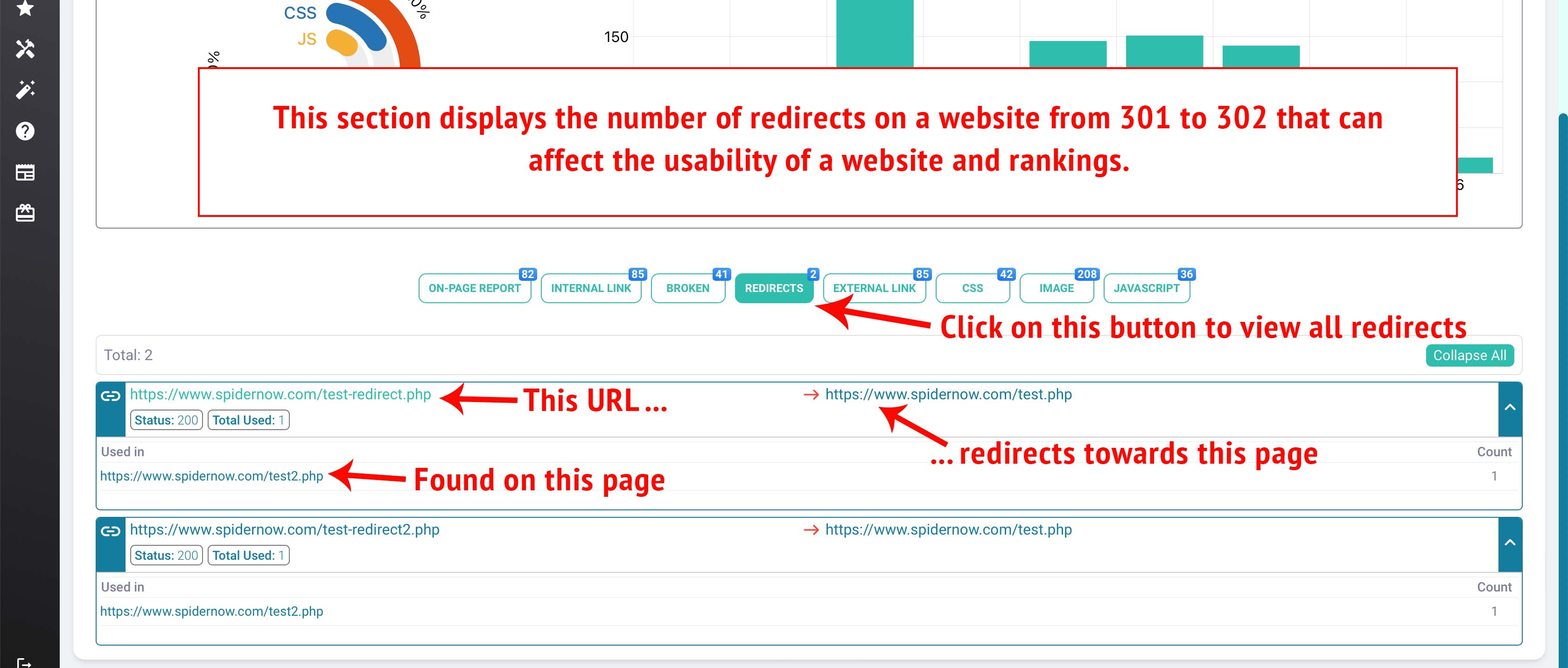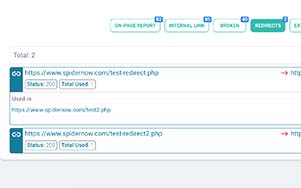What are redirects, and why are they important for SEO?
Redirects are instructions that automatically take users and search engines from one URL to another. They are important for SEO because they ensure that users and search engines can access the correct content, preserve link equity, and maintain website integrity during website restructuring, URL changes, or content migrations.
Using Redirects on your website for usability
When implementing redirects on your website, it is important to consider their purpose and use. To check your website for redirect issues, you can utilize the Redirect section in SpiderNow's user dashboard. Simply navigate to the dashboard and locate the "Redirect" button, which is conveniently positioned directly below the main graphs.
By accessing this section, you will be able to identify redirects that are functioning correctly as well as those that are not.

Which type of Redirect do I need?
Redirects and Technical SEO are two important topics that are frequently overlooked in the world of search engine optimization (SEO). So what is the importance of redirects and Technical SEO and how they impact the overall health and success of your website.
What is a redirect? A redirect is a technique used to redirect one URL to another. It is commonly used when a page on your website is moved to a new URL, or when you want to merge two websites or pages together. Redirects are essential for both user experience and SEO.
Redirects improve user experience by ensuring that they are directed to the correct page. There's nothing more frustrating for a user than clicking on a link and landing on a 404 error page. By using redirects, you can direct users to the correct page, provide a better user experience, and prevent them from leaving your site altogether.
Why is using the correct Redirects can help improve user experience?
In terms of SEO, redirects are crucial because they help search engines understand your website's structure and link equity. For example, if a webpage with a high link equity (number of external and internal links) changes its URL without redirecting, the search engines will no longer attribute that link equity to the new URL. By using a redirect, you can ensure that the link equity is attributed to the new URL.
There are several types of redirects, each of which serves a specific purpose. The most common types of redirects are 301, 302, and 307 redirects. A 301 redirect is a permanent redirect, which is used when you need to move a URL permanently to a new location. This type of redirect is the most commonly used and is best for preserving the link equity of the original URL.
Temporary Redirects, why should I use them?
A 302 redirect is a temporary redirect that is used for temporary changes. An example of when you would use a 302 redirect is when you're making updates to a page that you expect to return to the original URL shortly.
Meanwhile, a 307 redirect is similar to a 302 redirect, but it explicitly tells the search engines that the redirection is temporary and should be returned to the original URL after a specific time period.
While redirects are essential for a healthy website, they are just one piece of the puzzle when it comes to Technical SEO. Technical SEO is a term used to refer to the process of optimizing your website's structure and code for search engines.
The importance of Redirects for Technical SEO
Technical SEO is critical because it helps search engines crawl and index your website effectively. Additionally, using a Technical SEO tool ensures that your website is easily accessible and well-optimized, fast-loading, and free of errors and bugs. In turn, this will help improve your website's rankings and increase your visibility on search engines.
Some essential Technical SEO elements that all website owners should be aware of include metadata, sitemaps, canonical tags, and robots.txt files.
Metadata includes tags such as the page title, meta description, and header tags, which helps search engines understand the topic of your website and the relevance of your content. It is critical to optimize your metadata to include relevant keywords so that search engines can understand the relevance of your content. By doing so, you can increase the chances of your website ranking higher in search engine results pages (SERPs) for relevant search queries.
Sitemaps are another crucial aspect of Technical SEO. A sitemap is a file that serves as a roadmap for search engine crawlers. It provides an overview of your website's organization, pages, and content. By using sitemaps, search engines can crawl and index your website more efficiently, which helps improve your website's rankings.
Canonical tags are yet another crucial Technical SEO element. A canonical tag is a line of code that tells search engines which version of a web page to index. When there are multiple versions of a page with the same content, it can cause a problem known as duplicate content, which can impact your website's rankings. By using canonical tags, you can tell search engines that the original version of the page is the one that should be indexed, thereby preventing duplicate content issues.
When it comes to robots.txt files are used to control the behavior of search engine crawlers. The file instructs search engines which pages to crawl and which ones to ignore. By using robots.txt files, you can ensure that search engines do not crawl pages that you do not want them to index, which can help improve your website's rankings.
Redirects and Technical SEO are two essential elements of your website's health and performance. By implementing redirects and optimizing your Technical SEO elements, you can improve your website's user experience, search rankings, and overall online presence. By understanding the Technical aspects of SEO, you can make informed decisions about your website's development and ensure that it is well-optimized for search engines.


Web Developer & Digital Marketer










